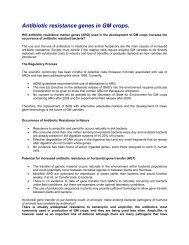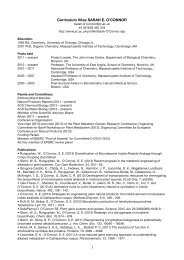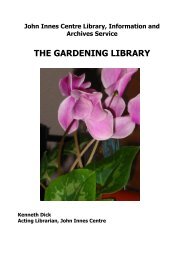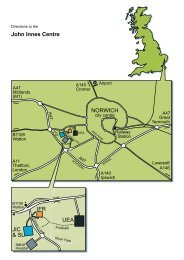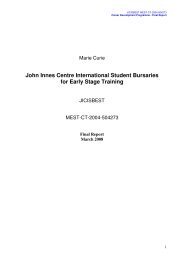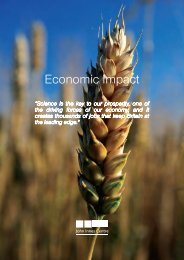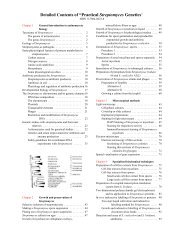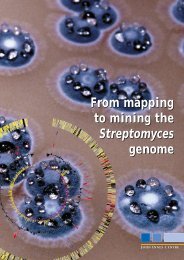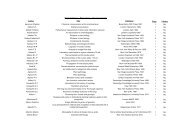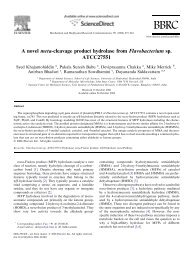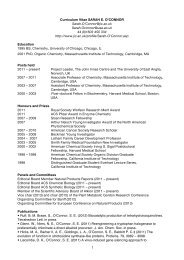1910s Timeline - John Innes Centre
1910s Timeline - John Innes Centre
1910s Timeline - John Innes Centre
Create successful ePaper yourself
Turn your PDF publications into a flip-book with our unique Google optimized e-Paper software.
1950 Bayfordbury officially<br />
opens<br />
The official opening of the <strong>John</strong><br />
<strong>Innes</strong> Horticultural Institute at<br />
Bayfordbury takes place on<br />
Friday, 2 nd June attended by 500<br />
guests, including Lord<br />
Rothschild, Chairman of the<br />
Agricultural Research Council<br />
and representatives of 15<br />
countries. Visitors are welcomed<br />
by Colonel F. C. Stern, chairman<br />
of Council, and are able to see<br />
the buildings, demonstrations of<br />
work in the laboratories, the<br />
experimental plots and the<br />
newly completed glasshouses.<br />
The occasion is described in<br />
Nature on June 17 th .<br />
A village, known as Broad<br />
Green, has been built for the<br />
married staff and twenty<br />
families are now<br />
accommodated on the estate.<br />
1950 Flower pigment research<br />
begins again<br />
Research on the genetics and<br />
chemistry of anthocyanins<br />
carried out at Merton from 1930<br />
to 1940 had to be terminated<br />
through war-time lack of staff.<br />
Since then the advent of paperchromatography<br />
methods, first<br />
introduced to biochemistry in<br />
1941 to separate and identify<br />
mixtures of compounds that<br />
are, or can be coloured, has<br />
simplified methods for studying<br />
the anthocyanins and has<br />
opened up new fields of<br />
pigment research. It is now<br />
possible to analyse flavones and<br />
similar compounds; formerly<br />
the analytical techniques<br />
available were too laborious and<br />
the quantities of material<br />
needed too large to make<br />
genetic work with flavones<br />
practical. In 1950 work on flower<br />
pigments resumes at JIHI with<br />
investigations of anthocyanins<br />
and flavones in Antirrhinum,<br />
Rosa, Primula sinensis and<br />
Chrysanthemum maximum. The<br />
JIHI staff are trained in<br />
chromatography methods by E.<br />
C. Bate-Smith and T. Swain at<br />
the Low Temperature Research<br />
Station in Cambridge.<br />
1950 Weekly seminars resume<br />
Weekly seminars were given by<br />
the staff and visitors to the<br />
Institution in the winter season<br />
from 1911 to 1915, from 1920 to<br />
1926, and were continued<br />
irregularly from 1926 to 1939.<br />
They were completely<br />
interrupted during 1939-1946<br />
and again from 1948-1949. At<br />
these seminars the chief genetic<br />
discoveries of the last 40 years<br />
have been propounded. Among<br />
the speakers have been Baur,<br />
Beadle, Biffen, Blaringhem,<br />
Bridges, Buller, Chambers,<br />
Fisher, Goldschmidt,<br />
Goodspeed, Gowen, Haldane,<br />
Harland, Johannsen, Lotsy,<br />
Mohr, Morgan, Muller, Punnett,<br />
Seifriz, Sturtevant, Vavilov,<br />
Watson, and Winge. The weekly<br />
seminar programme resumes at<br />
JIHI in October 1950.<br />
1950 Garden Research<br />
Department established<br />
In recognition of the fruitful<br />
work that William Lawrence has<br />
overseen as head of the Garden<br />
Department, and to relieve him<br />
from routine work, Darlington<br />
puts Lawrence in charge of a<br />
new ‘Garden Research<br />
Department’. <strong>John</strong> Newell<br />
becomes ‘Curator’ in charge of<br />
the gardens in his place.<br />
Lawrence’s services to<br />
horticulture are also recognised<br />
by the award of a Royal<br />
Horticultural Society ‘Victoria<br />
Medal of Honour’ in this year.<br />
One of the new projects that<br />
Lawrence oversees is the study<br />
of glasshouse climatology,<br />
aided by the appointment of a<br />
physicist, Dr Raymond Whittle,<br />
in 1952. The experience gained<br />
during these studies is later put<br />
to use in the design and<br />
Page 50 of 91



